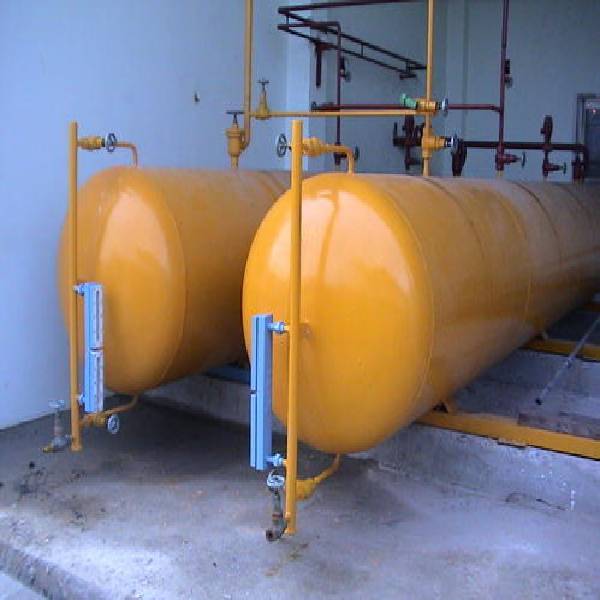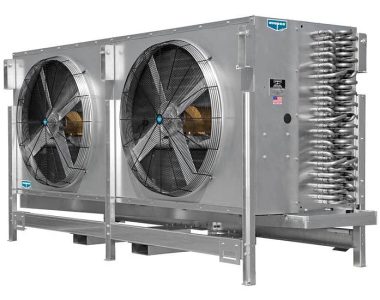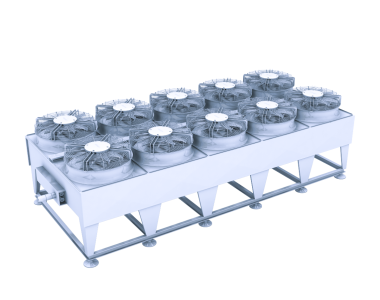
A high-pressure receiver is an essential component in many refrigeration systems, particularly those operating with larger capacities or serving multiple evaporators. It plays a crucial role in storing and stabilizing the high-pressure liquid refrigerant discharged from the condenser before it is distributed to the expansion device and evaporators.
Key Components and Functions:
- Storage Tank: The high-pressure receiver typically consists of a cylindrical tank with a capacity ranging from a few gallons to several hundred gallons, depending on the size and design of the refrigeration system. The tank is designed to withstand high pressures and is often constructed of steel or other suitable materials.
- Inlet and Outlet Connections: The receiver is equipped with inlet and outlet connections that allow the high-pressure liquid refrigerant to enter and exit the tank. The inlet connection is usually connected to the discharge line from the condenser, while the outlet connection directs the refrigerant flow to the expansion device.
- Liquid Level Control: Many high-pressure receivers are equipped with liquid level control devices, such as float switches or sight glasses, to monitor the level of refrigerant inside the tank. This ensures that the receiver is adequately filled with liquid refrigerant to supply the evaporators while preventing overfilling or underfilling.
- Safety Devices: Pressure relief valves and pressure gauges are often installed on the high-pressure receiver to prevent overpressurization of the system and provide pressure monitoring. These safety devices help protect the receiver and other system components from damage due to excessive pressure buildup.
Functions of a High-Pressure Receiver:
- Storage and Stabilization: The primary function of the high-pressure receiver is to store and stabilize the high-pressure liquid refrigerant discharged from the condenser. This helps ensure a consistent supply of refrigerant to the expansion device and evaporators, regardless of variations in system load or operating conditions.
- Liquid Refrigerant Management: By storing liquid refrigerant, the receiver helps prevent excessive liquid carryover into the suction line, which can damage the compressor and impair system performance. It also allows any non-condensable gases or impurities in the refrigerant to separate and collect at the top of the receiver, where they can be purged from the system.
- Pressure Equalization: The high-pressure receiver acts as a buffer between the condenser and the expansion device, helping to equalize pressure fluctuations and maintain stable operating conditions within the refrigeration system. This ensures efficient operation and extends the lifespan of system components.
- Facilitating Maintenance: Having a high-pressure receiver in the system facilitates maintenance activities such as refrigerant charging, system inspection, and repairs. It provides a convenient point for accessing and servicing the refrigerant circuit, helping to minimize downtime and ensure the smooth operation of the refrigeration system.
Selecting a high-pressure receiver for an ammonia-based refrigeration system involves several considerations to ensure optimal performance, safety, and reliability. Here are the key steps to follow when selecting a high-pressure receiver for an ammonia-based refrigeration system:
- Determine Refrigeration System Capacity: Begin by determining the refrigeration system’s capacity, including the total refrigerant charge and the maximum refrigerant flow rate. This information will help determine the size and capacity requirements of the high-pressure receiver.
- Consider System Operating Pressure: Ammonia refrigeration systems typically operate at higher pressures compared to systems using other refrigerants. Determine the maximum operating pressure of the system to ensure that the high-pressure receiver can safely contain the refrigerant under all operating conditions.
- Calculate Required Volume: Based on the system capacity and operating pressure, calculate the required volume of the high-pressure receiver. The receiver should have sufficient capacity to store an adequate amount of liquid ammonia to meet the system’s needs while allowing for proper liquid level control.
- Account for Safety Factors: Incorporate appropriate safety factors into the receiver sizing calculations to account for variations in system load, ambient conditions, and potential emergencies. It’s essential to ensure that the receiver has a sufficient safety margin to handle unexpected fluctuations in refrigerant flow or pressure.
- Select Material and Construction: Choose a high-pressure receiver constructed of materials suitable for handling ammonia, such as carbon steel, stainless steel, or other corrosion-resistant alloys. Consider factors such as compatibility with ammonia, strength, durability, and resistance to corrosion and fatigue.
- Evaluate Design Features: Look for design features that enhance the receiver’s performance and safety, such as pressure relief valves, liquid level controls, sight glasses, and drain connections. These features help ensure proper operation, pressure regulation, and maintenance of the receiver.
- Compliance with Standards and Codes: Ensure that the selected high-pressure receiver complies with relevant industry standards and codes, such as ASME Boiler and Pressure Vessel Code (BPVC) Section VIII for pressure vessels and ANSI/IIAR standards for ammonia refrigeration systems. Compliance with these standards ensures that the receiver meets safety and regulatory requirements.
- Consider Installation Requirements: Take into account installation considerations such as space availability, access for maintenance, and compatibility with existing system components. Ensure that the receiver can be installed and integrated seamlessly into the refrigeration system without compromising performance or safety.
- Consult Manufacturer’s Recommendations: Consult with reputable manufacturers or suppliers of high-pressure receivers for guidance on selecting the appropriate size, capacity, and design features based on the specific requirements of the ammonia-based refrigeration system.
By following these steps and considerations, you can select a high-pressure receiver that meets the needs of your ammonia-based refrigeration system, ensuring safe and efficient operation while minimizing risks and maximizing performance.
The test pressure and specifications of a high-pressure receiver (HPR) for an ammonia-based refrigeration system should adhere to industry standards and regulations to ensure safety and reliability. Here are the typical test pressure and specifications for an HPR:
- Design Pressure: The design pressure of the HPR should be determined based on the maximum operating pressure of the refrigeration system. For ammonia-based systems, which often operate at higher pressures compared to systems using other refrigerants, the design pressure of the HPR is typically specified to withstand pressures ranging from 250 psig to 400 psig or higher, depending on system requirements and regulatory standards.
- Test Pressure: The HPR should be hydrostatically tested at a pressure higher than the design pressure to ensure structural integrity and leak-tightness. The test pressure is typically specified as 1.5 times the design pressure or as required by applicable codes and standards. For example, the American Society of Mechanical Engineers (ASME) Boiler and Pressure Vessel Code (BPVC) Section VIII specifies a minimum hydrostatic test pressure of 1.3 times the design pressure for pressure vessels.
- Material Specification: The material of construction for the HPR should be selected based on compatibility with ammonia and its resistance to corrosion, fatigue, and other environmental factors. Common materials used for constructing HPRs include carbon steel, stainless steel, or other corrosion-resistant alloys.
- Pressure Relief Device: The HPR should be equipped with pressure relief devices, such as pressure relief valves, to protect against overpressurization and prevent catastrophic failure. The pressure relief device should be set to relieve pressure at a predetermined value slightly above the system’s maximum operating pressure.
- Liquid Level Control: Many HPRs are equipped with liquid level control devices, such as float switches or sight glasses, to monitor the level of liquid refrigerant inside the tank. These devices help ensure proper liquid level management and prevent overfilling or underfilling of the receiver.
- Drain Connections: The HPR should have drain connections for removing accumulated liquid or moisture from the bottom of the tank. Proper drainage is essential for maintaining the integrity of the refrigeration system and preventing corrosion or contamination.
- Quality Standards: The HPR should be manufactured in compliance with relevant industry standards and regulations, such as ASME BPVC Section VIII, ANSI/IIAR standards for ammonia refrigeration systems, and any other applicable local or national codes.
- Capacity and Dimensions: The capacity (volume) and dimensions of the HPR should be selected based on the refrigeration system’s requirements, including the total refrigerant charge, system capacity, and space constraints. The HPR should have sufficient capacity to store an adequate amount of liquid refrigerant while allowing for proper liquid level control and safety margin
Maintaining the high-pressure receiver (HPR) in good condition is essential for the safe and efficient operation of the ammonia-based refrigeration system. Here are some preventive maintenance steps to keep the HPR in optimal condition:
- Regular Inspection: Perform routine visual inspections of the HPR to check for signs of damage, corrosion, or leaks. Inspect the exterior surface, welds, fittings, and connections for any abnormalities.
- Pressure Testing: Periodically conduct pressure tests on the HPR to ensure its integrity and leak-tightness. Follow manufacturer recommendations and industry standards for pressure testing procedures and frequency.
- Liquid Level Control: Verify the proper operation of liquid level control devices, such as float switches or sight glasses, to ensure accurate monitoring of liquid levels inside the HPR. Adjust or replace faulty components as needed.
- Drainage System: Maintain the drainage system of the HPR to ensure proper removal of accumulated liquid or moisture. Clean drain lines, traps, and valves regularly to prevent clogging and ensure effective drainage.
- Corrosion Protection: Implement corrosion protection measures to prevent corrosion of the HPR’s surface and internal components. Consider applying protective coatings, corrosion inhibitors, or cathodic protection systems as appropriate.
- Safety Devices: Test and verify the proper operation of pressure relief valves and other safety devices installed on the HPR. Ensure that pressure relief valves are set to the correct pressure and replace any malfunctioning or worn-out components.
- Cleaning: Clean the interior and exterior surfaces of the HPR regularly to remove dirt, debris, or contaminants that may accumulate over time. Use appropriate cleaning agents and methods to avoid damaging the HPR’s surface or components.
- Insulation Inspection: If the HPR is insulated, inspect the insulation material for signs of damage, deterioration, or moisture ingress. Repair or replace damaged insulation to maintain thermal efficiency and prevent moisture buildup.
- Documentation and Record-keeping: Maintain comprehensive records of all maintenance activities, inspections, and repairs performed on the HPR. Keep track of test results, inspection reports, and compliance with regulatory requirements.
- Training and Education: Provide training to personnel responsible for maintaining the HPR on proper maintenance procedures, safety practices, and regulatory compliance. Ensure that maintenance personnel are knowledgeable about the specific requirements of the HPR and the refrigeration system as a whole.
Below is a checklist divided into daily, monthly, and yearly tasks for the preventive maintenance of the high-pressure receiver (HPR) in an ammonia-based refrigeration system:
| Maintenance Task | Frequency |
|---|---|
| Daily Tasks | |
| Visual inspection of HPR for leaks, damage, or abnormalities | Daily |
| Check liquid level in HPR | Daily |
| Verify operation of liquid level control devices (float switches, sight glasses) | Daily |
| Check pressure gauge readings on HPR | Daily |
| Verify operation of drainage system | Daily |
| Monthly Tasks | |
| Inspect insulation material for damage or deterioration | Monthly |
| Check and clean drain lines, traps, and valves | Monthly |
| Verify operation of pressure relief valves | Monthly |
| Check for corrosion on HPR’s surface and components | Monthly |
| Inspect welds, fittings, and connections for signs of wear or corrosion | Monthly |
| Yearly Tasks | |
| Conduct pressure test on HPR | Yearly |
| Inspect and test safety devices (pressure relief valves, alarms) | Yearly |
| Perform comprehensive visual inspection of HPR internals and externals | Yearly |
| Clean interior and exterior surfaces of HPR | Yearly |
| Verify compliance with regulatory requirements | Yearly |
| Review and update maintenance records | Yearly |


